Are you finding it challenging to create an online course? Where do you start? What software do you choose?
We’re going to help you build an online course that maximizes your bottom line, establishes your target audience, and actually get’s people engaged.
Building an online course is the ideal source of revenue for people who have real-life knowledge on a topic. For example, if you’re clued up on Foreign Exchange Market (Forex) and stocks, you can sell online courses on trading.
Your target audience would be people who want to learn how to trade. People use online courses to gain knowledge and skills on various topics.
Although you need extensive knowledge on the topic of your online course, you don’t have to be:
- A qualified teacher
- A digital marketing guru
- An expert in building online courses
- A tech wizard
Most people that start online courses don’t check those boxes. Instead, they nurture their knowledge and employ marketing techniques to generate profit.
But don’t worry, you’ll get there soon enough!
Globally, E-learning is rapidly expanding, and Statista forecasts this industry to surpass the $243 million benchmark by 2020.
Furthermore, 60% of internet users say that online courses suit their lifestyles more than traditional learning.

And 94% of students are highly satisfied with online courses and already have or believe they will generate a high Return On Investment (ROI).
With so much growth and adoration around online courses, you have to ask yourself “why not me?”
The truth is, there’s no reason you can’t get in on the action! Let’s dive into the rundown of creating online courses, starting with three examples of successful online courses.
3 Examples of Successful Online Courses and The Takeaways
1. Thrifty Homestead Academy
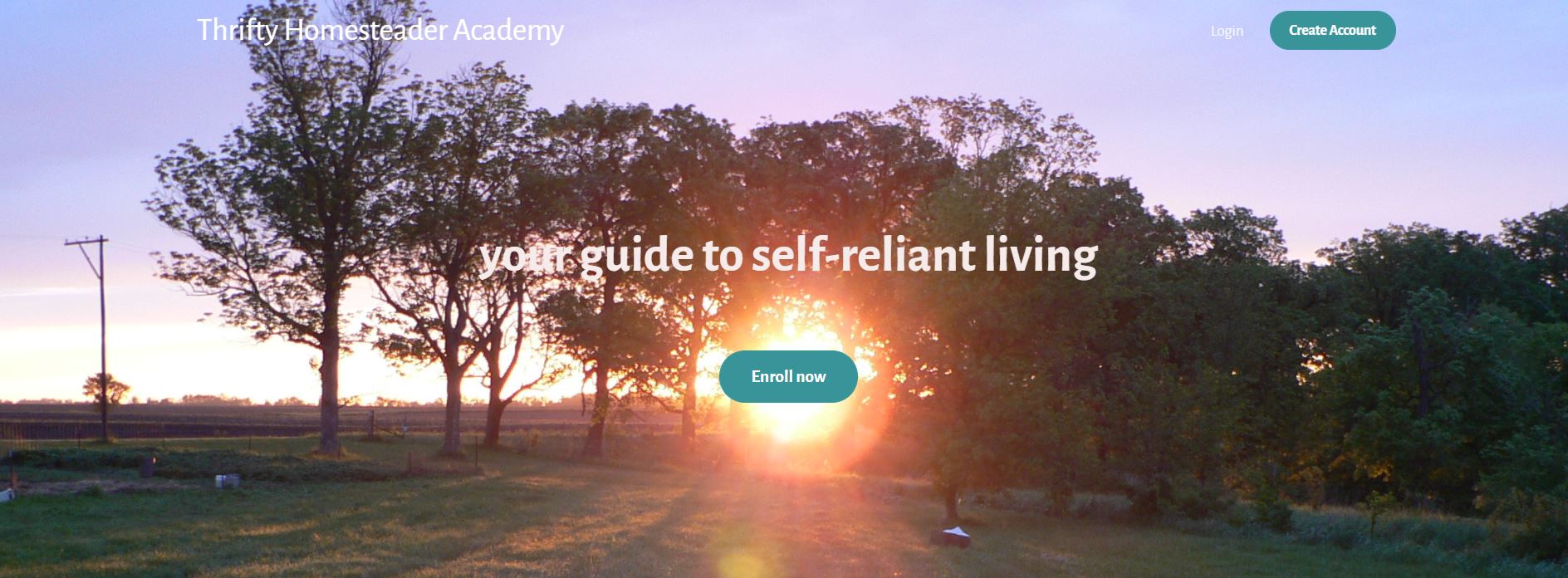
Thrifty Homestead Academy is an online course created by Deborah Niemann after she moved to the country.
Deborah is a bit of an icon in the world of online learning because of her steady growth and innovation in her courses.
After moving to the country, Deborah had an issue on her farm; her goats kept dying. She would take them to countless vets but nobody could help. Simultaneously, Deborah got involved in other homestead practices like making soaps and cheeses.
Occasionally, she would teach someone how to make their own soap or cheese. But she realized it would be better to teach a large group.
Word-of-mouth quickly spread (as it usually does), and everybody wanted to learn how to make cheese and soaps from Deborah.
Later, she published books on homesteading and raising goats, but this wasn’t bringing in the bread she wanted.
Creating The Online Course
After hosting online courses for a university, Deborah suddenly had an idea: she could sell online courses on how to raise goats!
Putting her plans in motion, Deborah signed up on a paid plan with Teachable and begun growing her email list.
To increase her email list, Deborah offered a free online course based on the blog article that generated the most traffic from social media to her website: “Copper Deficiency in Goats”.
The free course worked like a charm. And her email sign-ups flew through the roof.
To date, Deborah’s course is going strong and is an outstanding example of how anyone with the right skills and dedication can create a successful course.
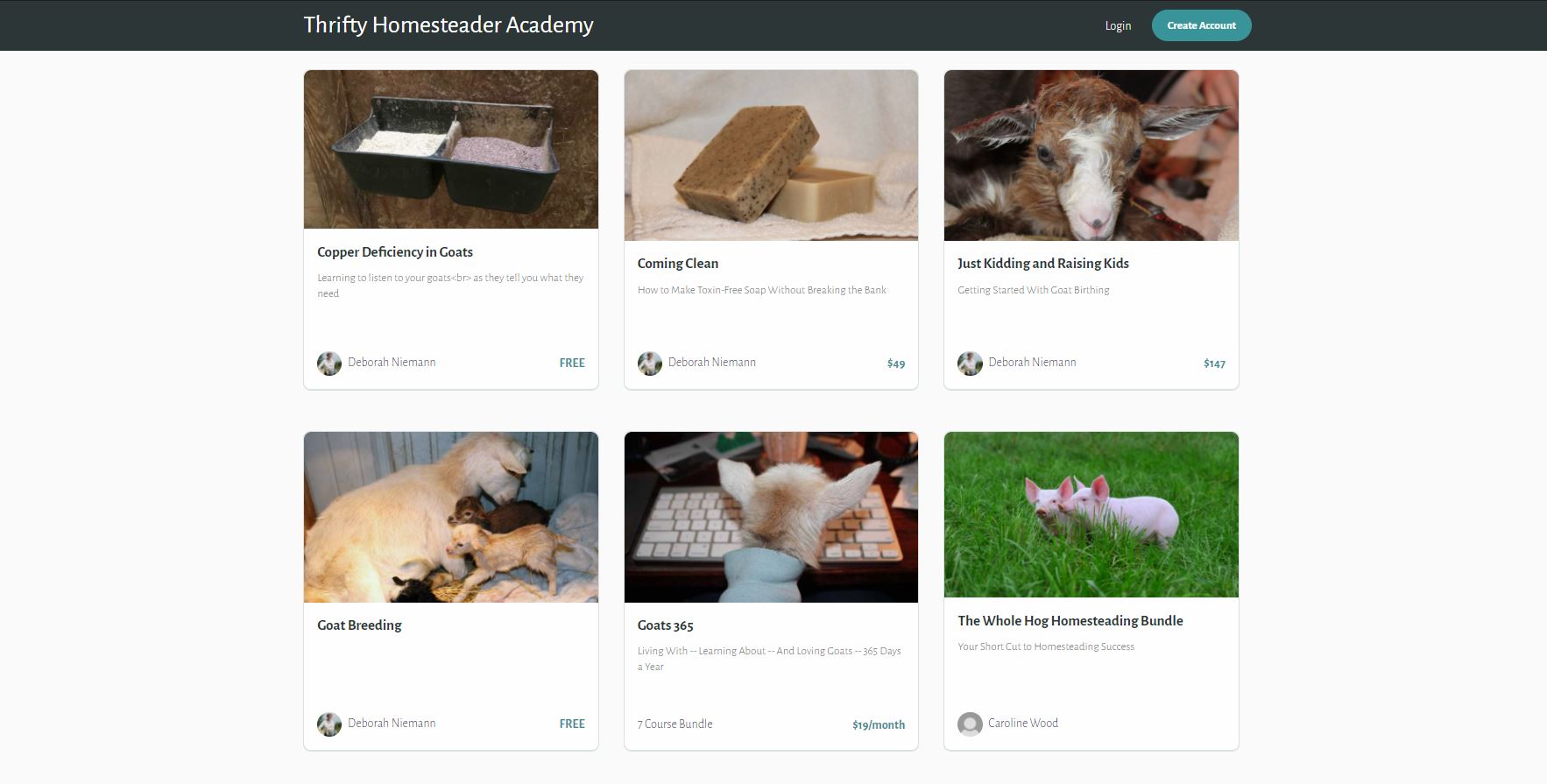
The Takeaway
Besides using a topic for her online courses that she was already familiar with, an important aspect to take away from Deborah’s online course is how quickly she started building her email list.
As soon as possible, offer potential clients a lead magnet that is valuable to them and helps solve their challenges.
If you’re unfamiliar with lead magnets, these are incentives you give consumers for their email addresses.
In this case, Deborah thought outside-the-box by using the blog article with the most traffic as the foundation for her lead magnet.
Apply this tactic for your online course, and make your emails personalized.
The more you’ve personalized your emails to the challenges, demands, and preferences of your ideal buyer, the more likely they are to respond to your marketing efforts.
The quicker you build your email list with prospects who fit your ideal buyer persona, the sooner you can start racking up sales for your online course!
2. The Student Motivation Course
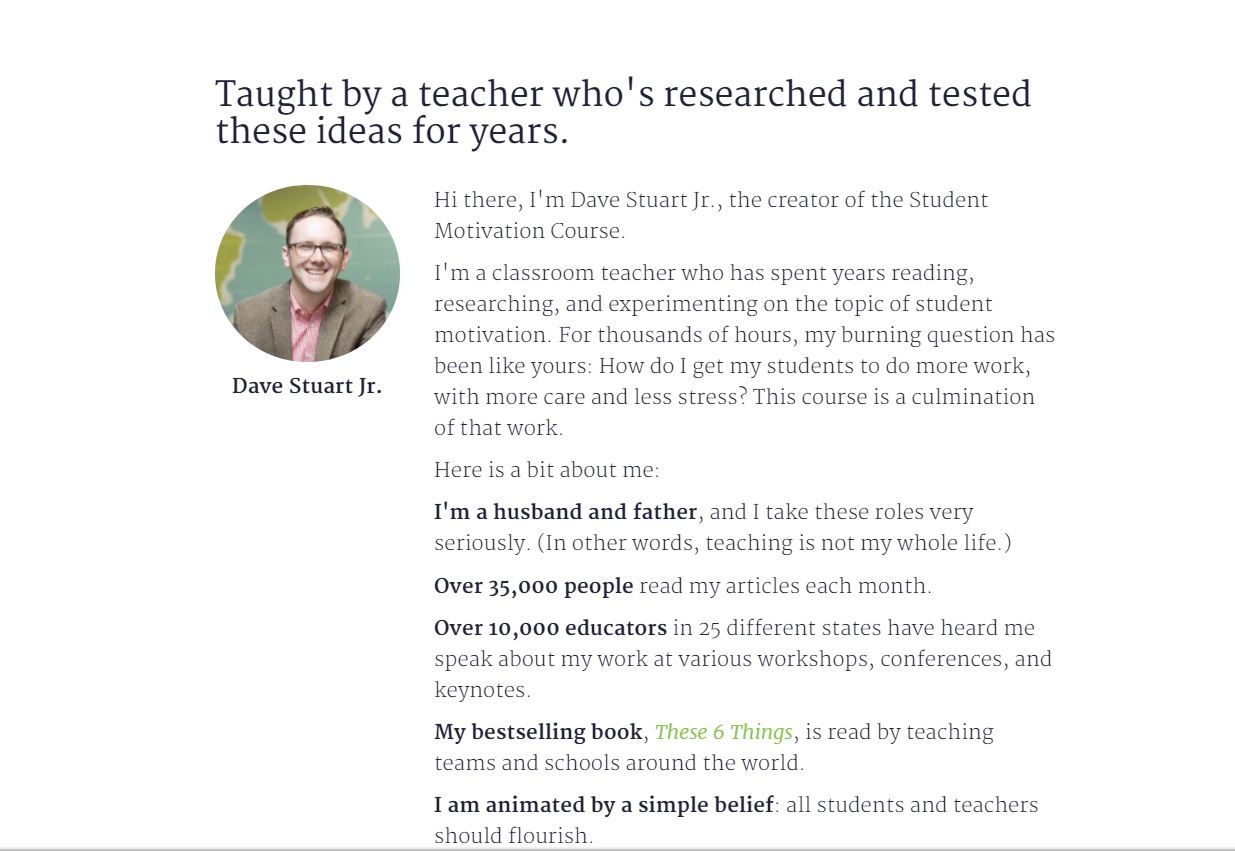
Do you want to create an online course, but you’re scared you won’t have enough time between your 9-5 and spending time with your family?
Take notes from this example!
Dave Stuart Jr. is a seasoned teacher with a full-time job and a family. However, he still made it possible to create the Student Motivation Course.
The Student Motivation Course helped k-16 teachers better understand and connect with their learners to encourage their learners to be more interested during lessons.
Dave noticed the worrying amount of uninterested learners showing up at school. Consequently, he began sifting through research on human motivation to understand how to motivate his students.
Creating The Online Course
Having a classroom full of students for 5 hours a day and unscheduled visitors almost every other hour, Dave found recording his lessons to be the biggest challenge.
After enough trial and error, he found a rhythm that works, and a month later; the course was ready.
Unlike recording the course, marketing for Dave was easy. Whenever he had another breakthrough on student motivation, he would write a blog article about it and promote the course waitlist at the end of his recording.
In other words, before concluding his course, he mentions a waitlist for another course based on valuable information.
As a result, by the time the course was ready to launch, Dave had a long list of people on his waiting list.
Credited to his course, Dave has helped countless teachers keep their students motivated and interested during lessons.

Also, many schools have reached out to Dave in hopes he’d host a workshop for their teachers.
What started as one online course has now opened up various revenues for Dave!
The Takeaway
The key from this example of online courses is the waitlist tactic. Mentioning a waitlist will give your audience an idea of what to expect for your next course. And it adds urgency around that course.
Also, it’s convenient to have people already signed-up for the next course before it starts. This method guarantees participants for your next course, which takes the load off having to gain new ones.
Additionally, a notable strategy from this online course example is the research Dave put into his topic.
He sold one topic “Student Motivation” breaking down various aspects of the topic. And that is because of thorough research.
Even if you think you know all the ins and outs of your online course topic, do a ton of research and keep updated with changes and trends for that topic.
Staying updated will help you launch evergreen online courses that respond to the current challenges your target audience face.
3. Exploring Texture and Pattern

This online course was created by two brothers, Sam and Joe Pitcher, and their mother, Sue Stone.
Sue Stone had always been a renowned textile artist in the UK, which lead her to become the Chair of the most prolific textile art organization in the UK. And her work featured in multiple embroidery magazines.
Frequently, Sue would travel around the world to host textile workshops, teaching enthusiasts everything she knew.
But her sons felt that as she grew closer to seventy, there had to be a better alternative for her to teach people without the need to travel.
And so, Exploring Texture and Pattern was born.
Creating The Course
Without a bit of sales experience between the two, the online course started on a rough note.
The brothers underestimated the sheer work and effort that all the stages of building an online course would entail. And this ignorance pushed the pair to take on the entire workings of building the online course-creating newsletters, writing blogs, posting on social media, building sales pages, and so forth.
Because of the high volume of work, at first, they missed almost every deadline!
There was a lot of back and forth in their marketing techniques, in terms of how to communicate to their audience and the style of how they market.
The brothers found it challenging to capture a method of promoting their online course that didn’t feel inauthentic but also wasn’t too direct.
After trying a few techniques, Joe and Sam could identify which felt the most authentic to their brand and tasteful to their community,
Not to mention how challenging it was to win over a community that was complacent with in-person teaching!
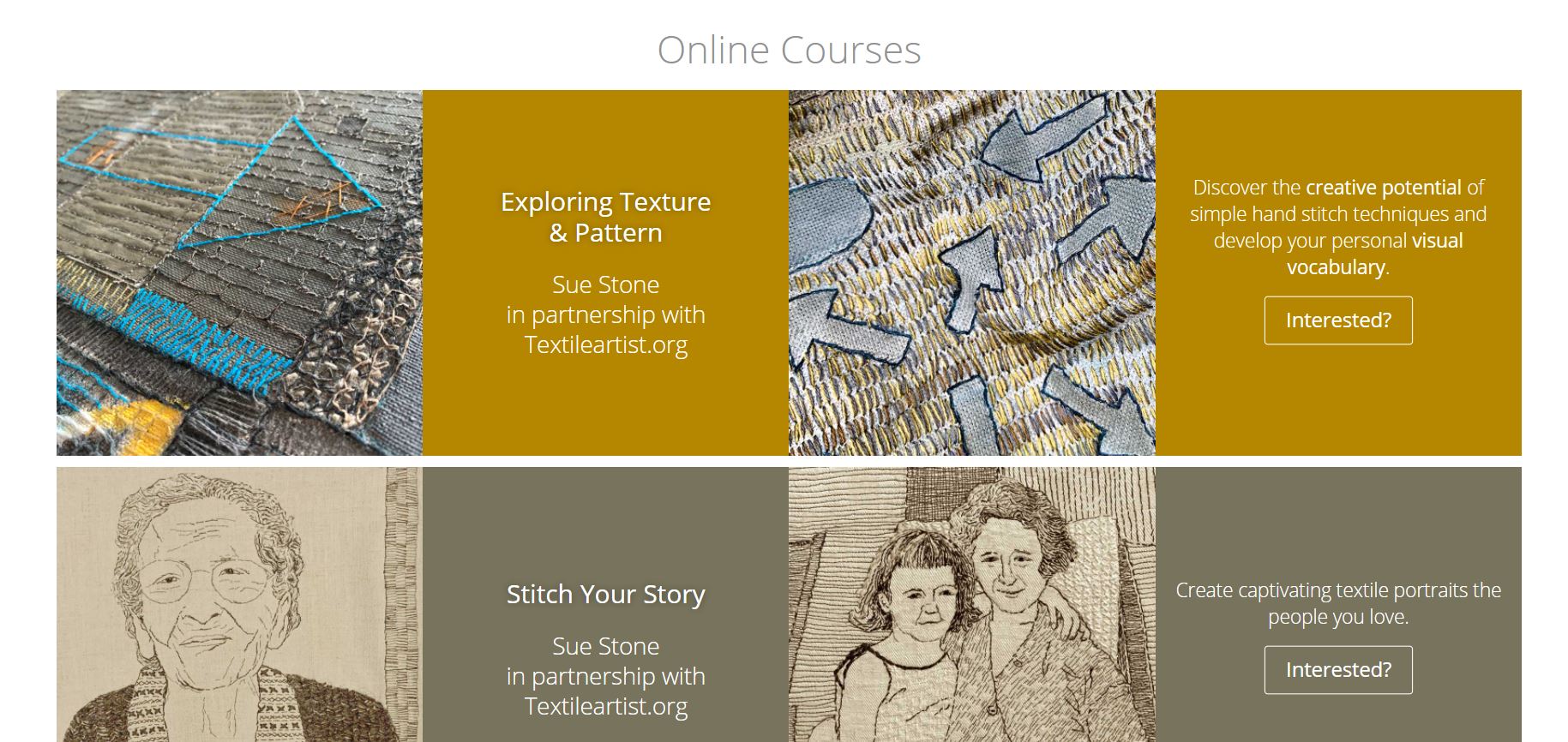
The Takeaway
What we can learn from this family run online course is that listening to your audience along with extensive trial and error are the key.
Don’t be shy to try different ways of communicating with your audience to understand what not only works for them but what reflects your brand well.
If you’re in the Pitcher-Stone family’s shoes and your audience is already established, you need to find a unique way of communication to pick out those buyers who will evolve with your change. This is aside from attracting new buyers.
You can do this by engaging with your audience. Get on a call with your “regulars” and find out what is working for them and what isn’t.
Your students are the people paying for your course. They are people who are getting you closer to financial freedom, so more than anything, what they have to say matters.
If you can’t call your consumers, use surveys, polls, or quizzes to get feedback. Change your strategy until it archives the goals you set for your online course.
8 Steps to Create an Online Course
1. Identify Your Niche and Target Audience
This goes for any business. Know your customer and product like the back of your hand.
For example, let’s say you want to create an online wellness course. Be specific to find a niche and target audience by asking yourself:
- What kind of wellness? Yoga Practices? Dietary advice? Mental health practices and advice? Substance abuse help?
- What would be beneficial to my target audience that my competitors don’t offer? Such as acknowledgment, give a shout-out to your regular students. Or students that have contributed to your online courses the most. I bet your competitor isn’t doing that!
- What kind of person is my ideal student, and what challenges would my online course help them overcome? Is your ideal student a stay-at-home mom who only has an hour of free time and is dying to practice yoga? Or maybe a sports-fanatic who needs advice on the healthiest diets and most effective exercise routines.
When you answer these questions, be as specific as possible. If you know exactly who your ideal buyer is, it will be easier for you to personalize your marketing techniques to appeal to them.
Because 74% of consumers feel frustrated when their shopping experience is not personalized. And 80% of consumers are more likely to do business with a brand that provides a personalized experience, knowing your ideal buyer and your niche is imperative!
2. Research, Research, and more Research!
If you’re going to sell an online course, you need to provide your audience with information that is accurate, beneficial, and evergreen.
This is where extensive research comes in.
First, you need to make a list of all the potential subtopics for your online course.
Once your list is done, you need to put research into those topics. For extra meaty topics, give yourself more time for research and use multiple resources like books, interviews with experts, case studies, and so forth.
You need to project as much valuable information through your online courses, so your audience finds a reason to join your course.
Before and during your research, be sure to plan. For meaty topics, schedule them further down your content calendar, giving yourself enough time to be prepared.
Furthermore, while you research, use sites like Reddit and Quora to find out what people are asking. Doing this will give you better direction for your content and marketing strategies.
Finally, find out who your competitors are. These would be brands that target your audience with similar content.
For your competitors, evaluate:
- Where do my competitors have the advantage?
- What opportunities do my competitors have?
- What are the key differences between my business and my competitors?
- What are my competitors neglecting?
- How can I have an advantage over my competitors?
Take a while to evaluate these questions and find detailed answers. By running an in-depth competitor analysis, you’ll find out where your business is lacking and how you can gain the upper-hand.
Although research is an essential step before launching your online course, keep your research updated all the time. Doing this will help you maintain evergreen content focused on the current challenges of your ideal buyer.
3. Set Goals for Your Online Course
Now that you’ve gathered all your research, it’s time to outline your course and set the foundation.
You know who your competitors and ideal buyers are, so what would SMART goals for your business be?
SMART= Specific, Measurable, Realistic, Attainable, and Time-bound.
Set SMART goals for the performance of your online course in terms of the Return on Investment (ROI) and Key Performance Indicators (KPIs).
A few KPIs for online courses are:
- User engagement
- Average test score rates
- Average completion rate
- Customer satisfaction rate
- Reactivation of past users
-
Customer repeat rate
-
The number of users
- The number of new users
Also, you need to set a learning objective too. What skills/knowledge should your learners have after the course?
To find out if you achieved your learning objective, survey the course and get feedback from the course participants.
4. Choose an Online Course Builder
If you want an online course that converts, you’re going to need a powerful online course builder.
While you need to decide with your budget in mind, you also need to ensure you have all the essential features in your online course builder.
This will eliminate the need to integrate third-party software for additional features, making the process more complicated.
To make your life easier, here are the three best online course builders in the market.
1. Udemy
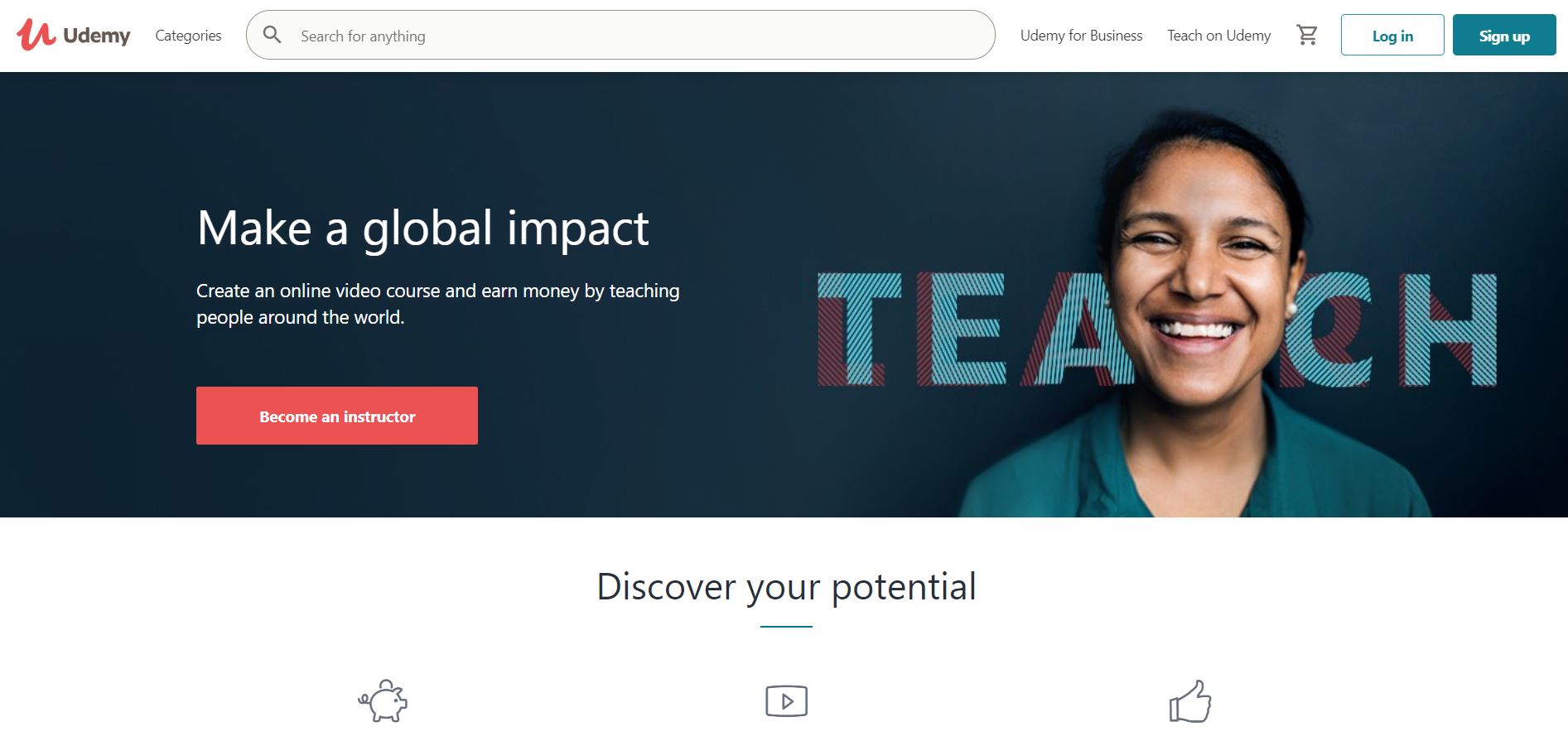
I’m placing Udemy right on top of this list because this online course builder is ideal for newbs. With over 35 million students and over 45 000 instructors, Udemy hosts courses on diverse topics.
To get started on Udemy, you need to register as an instructor. Your profile will have to be approved before you start your online course, and when it is, you can begin the planning stages on Udemy.
Main Features of Udemy:
- Quizzes
- Assignments
- Discussion prompts
- Udemy can review your videos and give you feedback along with suggestions for equipment
- Teach Hub, which offers tons of training material
- Marketplace insights to help you choose evergreen course topics
- View top-earning courses, search volume for your topic, the best promotion channels, and more!
Udemy charges:
- 3% revenue share on course sales through instructor coupons.
- 50% revenue share on course sales via organic traffic or Udemy promotions.
- 75% revenue share on course sales generated through Udemy’s paid user channels.
Pros:
- Features are a perfect solution for building a successful online course.
- The vast amount of training material makes it seamless for newbies to combat any friction.
- Available on mobile.
- A large variety of course topics.
- Easy to manage courses and analytics.
Cons:
- Revenue share percentages are too high for most businesses. And businesses can’t budget to pay a specific amount.
- Crowded user-interface.
- Certificates aren’t as credible as they aren’t endorsed by universities.
2. Teachable
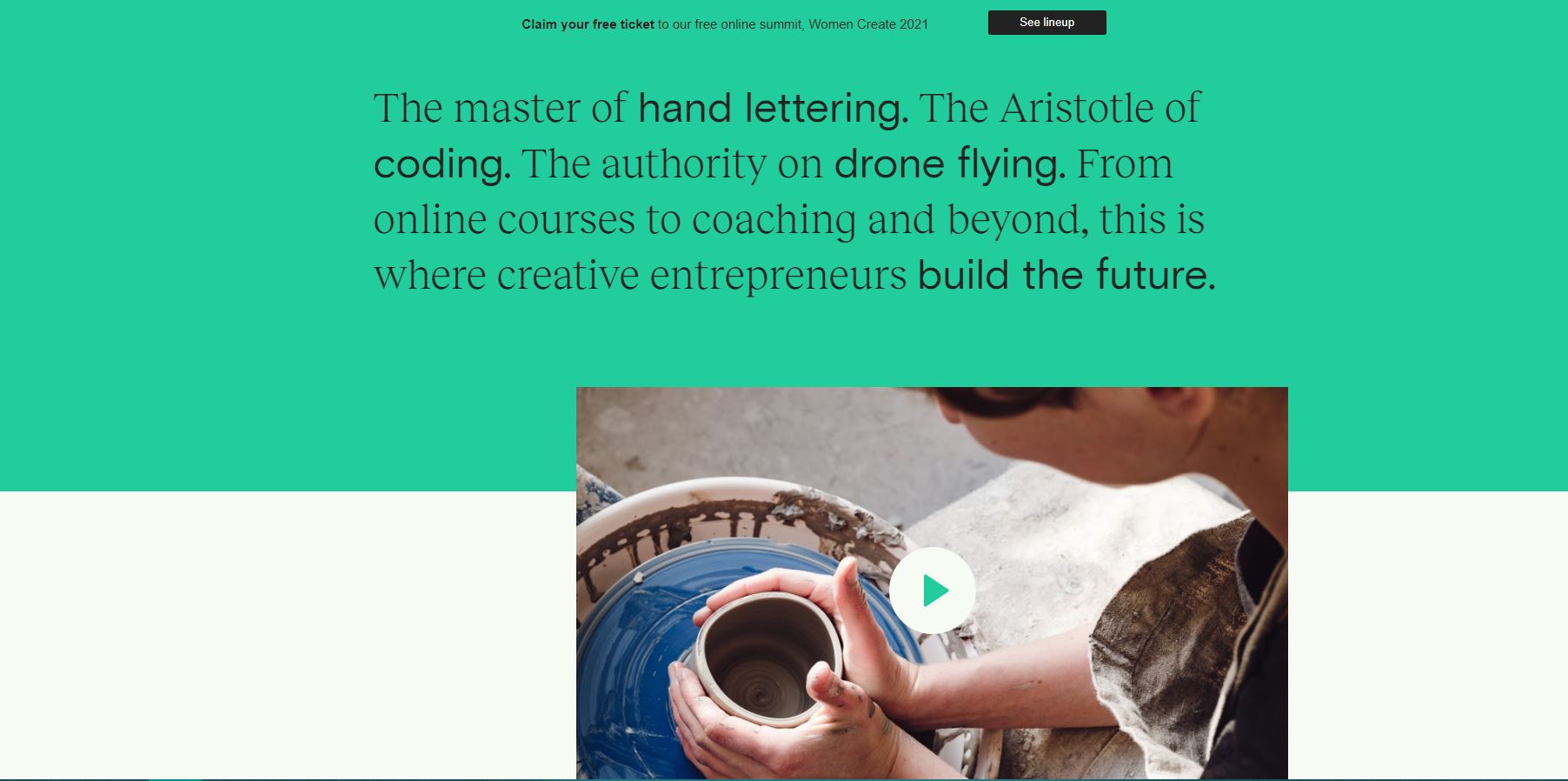
Being in the online course creator game for almost seven years, Teachable is a common choice amongst businesses and individuals. Teachable is relatively a big jump from Udemy, as this course builder is more intricate.
Starting on Teachable, you’ll have to customize your course, followed by building landing pages and your website.
Main Features of Teachable:
- Track sales and student insights
- Add authors, team members, and customize their permissions and roles
- Call hosting
- Course completion certificates
- Custom domain
- Intuitive landing page editor
- Quizzes
Teachable charges:
- $29 p/m for the Basic plan
- $99 p/m for the Pro plan
- $249 p/m for the Business plan
Pros:
- Free summits for instructors every year.
- Easy to bundle courses and add a discount.
- Automatically pays your affiliates.
- Convert Thank You pages to one-click upsell pages.
Cons:
- Sales pages and one-click upsell pages are cumbersome to create.
- Teachable doesn’t market your course to students.
- Lower prices are steep for the features offered.
3. Thinkific

This online course builder takes the guesswork out of creating an online course by providing ready-made templates and refined features.
Falling under the category of an all-in-one solution, Thinkific has powered over 100 million courses with over 50 000 creators.
When you start on Thinkific, unlike other course builders, you’ll start on a template with cues and suggestions instead of a blank page.
Main Features of Thinkific:
- Simple drag-and-drop editor
- Quizzes
- Surveys
- Discussions
- Private and hidden courses
- Multiple instructors
- Evergreen and expiring content
- Full access to HTML and CSS for website creation
Thinkific charges:
- $49/mo for the Basic plan
- $99/mo for the Pro plan
- $499/mo for the Premier plan
Pros:
- Features are highly customizable
- Simple and clear user-interface
- Vast features require no need for other tools
- Users report quick and friendly customer support
Cons:
- Pricing is unaffordable for small businesses.
- Lack of sufficient functions to showcase student feedback in various layouts.
- The quiz feature is tricky.
5. Create the Content
You’ve almost completed your online course!
Your content is going to be the selling point of your online course. We’ve already covered that it needs to be personalized to your ideal buyer, so they respond to your course. And it needs to be valuable.
But creating the content for your online course will take a lot more than that.
You need to decide on the content you’re going to use and then move on to perfecting that content.
For starters, the different content for online courses are:
- Text content
- Photo/video content
- Screencasting content
Screencasting content is usually direct and clear enough on its own. But for text, you want to combine other content types as only text can be boring. And for photo/video content, add text for context.
Perfecting your content
Imagine the grave feeling of realizing your online course has a typo, or the sound is of terrible quality?
Therefore you have to perfect your content. Don’t stress about investing in start-of-art editing software. iMovie for videos, Grammarly for text, or anything similar will do the trick.
You need to ensure your online course content:
- Has no grammar or spelling errors
- Makes sense
- Captures the point
- Has clear and good quality sound and lighting
- Is original!
The best way to perfect your content is to record a small portion of your online course and then adjust your next recording based on your student’s feedback.
This method will allow you to improve on your online courses constantly. While finding out what your audience likes and dislikes about your content.
6. Create an Online Community for Your Course
Create a place for all your learners to gather and discuss your content. In other words, build an online community!
An online community allows you more direct interaction with your learners and more insight into who your audience is. Plus, your students who need help have a place to assist each other. Before you know it, this closely connected community will become loyal students.
5 Tips for your online community:
- 1Get your community interacting by initiating conversation.
- 2Host regular video calls/webinars or go LIVE.
- 3Encourage your community members to network.
- 4Monitor the behavior of community members closely to secure a friendly environment.
- 5Add personality to your interactions with community members.
7. Share Your Course and Engage
Now that you’ve done all the dirty work, tell the world about your online course!
Use every marketing channel you have available to make people aware of your course.
Not sure where to start?
10 Tips to Market Your Online Course:
- 1Treat your course as a product launch. Set up a “Coming soon” landing page, use a count-down timer on social media and in your email campaigns too!
- 2Spread the word on social media. Consistently post-high-quality content as a teaser of your course, the progress of your course, or students who completed your course.
- 3Start podcasting. Through podcasting, you can reach a larger audience, and who doesn’t listen to podcasts nowadays?!
- 4Use social media paid to advertise. Share marketing material on social media boosted by paid advertising to extend your reach.
- 5Partner up with icons or respected figures in your niche. Make sure you approach a brand that is not your competitor!
- 6Guest feature on blogs or podcasts. If you know a blogger or podcaster who would be happy to promote your online courses, DO IT!
- 7Offer a discount for the first round of students who join your online course. It doesn’t have to be a huge discount. But enough to persuade potential students!
- 8Email market. Optimize your lead generation and email list to market your online course to your subscribers.
- 9Translate your course. Want to tap into another market? Translate your course into different languages to be accessible for students worldwide.
- 10Create a teaser mini-course. Give students a taste of what your course will entail by offering a mini-course.
8. Evaluate and Improve
When the dust settles, and your online course has concluded, it’s time to evaluate how well you performed.
The first thing you need to evaluate is: Did my students confirm I achieved my learning aim?
The next aspects you want to evaluate are:
- Where could I improve?
- What was my biggest learning curve?
- Did I meet my financial objectives?
- Did I meet my financial objectives?
- What was the best marketing tactic I used?
- How did my students respond to my course?
- What was a unique aspect of my course, that sets me apart from my competitors?
- or my next course, what will I repeat, and what will I leave out completely?
Document the answers to these questions so you can apply this knowledge to your next online course.
Getting Feedback
A major part of improving your future online courses is getting feedback from your students.
You can do this through a survey, asking a direct question, asking students to rate your service, or anything similar.
Feedback is critical. As a teacher, it’s easy to overlook negative aspects or friction that affects your students.
Plus only one out of every 26 consumers voice their complaints. The other 25? They leave without saying a word! By giving your students a voice, you will cut those 25 people down to 0.
Also, students will feel that you genuinely care about their experience. And the value of your course. Which further motivates them to sign-up for your course, and spread the word.
Conclusion
Phew, what an article!
Building an online course requires a lot of work and dedication, and while some of us don’t have the capital of Elon Musk or Jeff Bezos, the commitment and drive are still there.
This article gave you the eight steps to building an online course, the best online course builders, and three examples of successful courses that you can learn from.
If anybody with enough determination can create an online course that drives insane sales, why can’t you?

